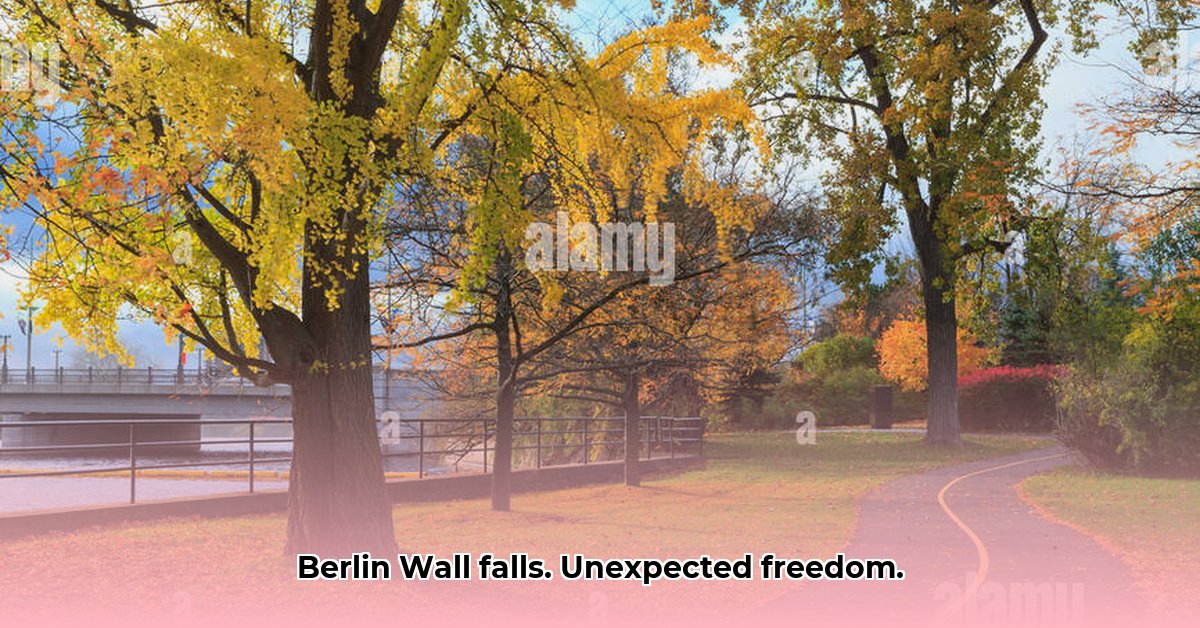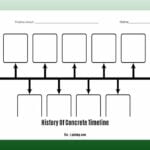Picture Berlin in November 1989: a city cleaved in two, a biting wind cutting through the concrete canyons created by the Berlin Wall. This isn’t just a history lesson; it’s a gripping narrative of how that wall crumbled, paving the way for a unified Germany. The story begins with subtle shifts, fueled by Mikhail Gorbachev’s reforms in the Soviet Union and a surge of peaceful revolutions across Eastern Europe. Learn more about the power of information spread by the printing press. We’ll encounter ordinary citizens, shrewd politicians, and influential world leaders, all players in this historic drama. From a press conference that sent seismic waves through the East German government to the spontaneous, largely peaceful breach of the border, we’ll dissect the chain of events that led to the wall’s fall. Prepare for a journey through a transformative moment – a time when a wall came down, and the world was forever altered.
The Fall of the Berlin Wall: The Defining Moments of Germany’s Reunification
For nearly three decades, the Berlin Wall stood as a stark symbol of the Cold War divide, a concrete gash across a city and a nation. By 1989, however, the wall symbolized more than just a physical barrier; it represented the oppressive control of the East German communist regime, a control that was on the verge of collapse.
Life Behind the Wall: The Stifled Existence in East Germany
Envision a life where the government dictates every aspect of your existence – from your career prospects to your travel possibilities. This was the reality for East Germans. The economy stagnated, basic necessities were scarce, and opportunities seemed as restricted as the “death strip” along the wall. Frustrations were whispered in hushed tones, dreams of a life beyond the wall – a life seemingly enjoyed by relatives in West Germany – fueled a yearning for freedom that grew with each passing day. It wasn’t merely a political desire; it was a deeply personal longing for a better future for themselves and their families, a chance to experience the opportunities readily available in West Germany. Everyday life in East Germany was a constant reminder of what was lacking.
The Thaw in the East: How Soviet Reforms Triggered a Domino Effect
Across the border, within the Soviet Union, seismic changes were underway. Mikhail Gorbachev initiated Perestroika (restructuring) and Glasnost (openness), ambitious reforms aimed at revitalizing the Soviet system. However, these reforms carried unintended consequences. The Soviet Union’s tight grip on its satellite states, including East Germany, began to loosen. The Soviet Union, grappling with its internal challenges, found it increasingly difficult to maintain its iron-fisted control over its Eastern European neighbors. This shift created a ripple effect, ultimately contributing to the reunification of Germany. As people across Eastern Europe began to rise up, demanding change, the seemingly impenetrable communist bloc began to show fissures.
Echoes of Freedom: The Wave of Revolutions Sweeping Eastern Europe
Poland saw the rise of Solidarity, a powerful labor movement that challenged and ultimately ousted its communist leaders. Hungary dismantled its border fence with Austria, creating an opening to the West. Czechoslovakia experienced its peaceful “Velvet Revolution.” These were largely non-violent uprisings, delivering a resounding message: change was within reach, and it was happening now. Inspired by these victories and frustrated by their own circumstances, East Germans found the courage to demand change. The peaceful revolutions in neighboring countries offered new hope and a blueprint for change.
The Crack in the Concrete: A Misunderstanding That Opened the Floodgates
The pivotal moment arrived on November 9, 1989. Günter Schabowski, a high-ranking East German official, held a press conference to announce a new travel policy, intended to ease restrictions on East Germans traveling to West Germany. However, his delivery was far from clear. He vaguely stated that the policy would take effect “immediately, without delay.” This ambiguous announcement, a simple misunderstanding amplified by the global media, became legendary.
News outlets interpreted Schabowski’s words as an immediate opening of the border. At the Berlin Wall, crowds gathered, seeking to cross into West Berlin. Border guards, caught off guard and lacking clear instructions, eventually – and reluctantly – opened the gates. The floodgates opened, unleashing a wave of joyous celebration. The unexpected crack in the wall rapidly transformed into a gaping chasm.
From Division to Unity: The Wall’s Fall and Germany’s Rebirth
Within hours, the Berlin Wall, once a symbol of oppression and division, was breached. Jubilant crowds surged through the checkpoints, embracing loved ones they had been separated from for years. The atmosphere was charged with the electricity of newfound freedom. It wasn’t just about crossing a border; it was about reclaiming lives, hope, and a future. The fall of the wall ushered in Germany’s reunification.
While the reunification process presented significant challenges – economic disparities between East and West Germany created considerable hurdles – the spirit of unity propelled the nation forward. Germany, once divided, was whole again. The determination to overcome these challenges was unwavering.
A World Transformed: The Global Impact of the Wall’s Collapse
The fall of the Berlin Wall extended far beyond Europe; it resonated globally. It symbolized the end of the Cold War, the collapse of communist regimes, and the triumph of the human spirit. It inspired movements for democracy and freedom worldwide, demonstrating that even the most formidable obstacles can be overcome through courage, perseverance, and a touch of serendipitous miscommunication. The world was irrevocably changed. The remnants of the Berlin Wall serve as a powerful reminder that hope can flourish even in the face of seemingly insurmountable odds.
Gorbachev’s Reforms: An Unintended Catalyst for the Fall of the Berlin Wall
Key Takeaways:
- Gorbachev’s policies of Perestroika (economic restructuring) and Glasnost (openness) inadvertently weakened the Soviet Union’s dominance over its Eastern European satellite states.
- The relaxation of Soviet control empowered pro-democracy movements, including those in East Germany, to demand greater freedoms.
- Increased access to information, facilitated by Glasnost, exposed the economic disparities between East and West Germany, fueling discontent and a desire for change.
The Berlin Wall, an enduring symbol of the Cold War division, didn’t fall because of a single, isolated event. Its collapse was the culmination of years of pent-up tensions, internal struggles within East Germany, and, most significantly, the unforeseen consequences of Mikhail Gorbachev’s reforms in the Soviet Union. How did Gorbachev’s reforms indirectly contribute to the fall of the Berlin Wall? The answer lies in the ripple effect of Perestroika and Glasnost.
The Unforeseen Repercussions of Perestroika and Glasnost
Gorbachev envisioned Perestroika as a means to revitalize the stagnant Soviet economy, plagued by inefficiency and a lack of innovation. He aimed to introduce elements of market economics to stimulate productivity. However, his reforms inadvertently weakened centralized control, creating a power vacuum that Eastern European nations were quick to exploit. Simultaneously, Glasnost, intended to foster transparency and accountability within the Soviet system, unleashed a torrent of pent-up dissent and demands for political reform. This newfound openness allowed information – including news of the West and its freedoms – to penetrate the Iron Curtain, igniting unrest among East Germans. Did Gorbachev anticipate unleashing such potent forces of change?
Imagine a dam holding back a raging river. Perestroika and Glasnost were akin to cracks appearing in that dam. Initially, the leaks were small, but each crack allowed greater pressure to build, ultimately leading to the dam’s catastrophic failure.
The Unraveling of East Germany Under Mounting Pressure
The East German government, already grappling with economic difficulties and widespread dissatisfaction, found itself increasingly isolated. Gorbachev’s new Soviet policy, which signaled a withdrawal of support for repressive regimes within the Eastern Bloc, emboldened pro-democracy movements across Eastern Europe. The “Brezhnev Doctrine,” which had justified Soviet intervention to suppress dissent in satellite states, was effectively abandoned. This lack of Soviet backing emboldened those seeking change in Eastern Europe and was a significant factor in Germany’s reunification.
The fall of the Berlin Wall wasn’t a spontaneous impulse; it was the culmination of a carefully orchestrated series of events. Heightened pressure from within and the absence of a Soviet crackdown created a perfect storm for change.
The Domino Effect: Peaceful Revolutions Across Eastern Europe
The success of peaceful revolutions in Poland, Hungary, and Czechoslovakia further undermined the legitimacy of the East German regime. East Germans witnessed their neighbors achieving freedoms they were denied, prompting them to demand their own share of liberty. Did the images of freedom in neighboring nations make the oppressive reality of the Berlin Wall even more unbearable?
The situation in East Germany was rapidly becoming untenable. The government, clinging desperately to its authoritarian grip, found itself unable to stem the rising tide of popular discontent.
The Moment of Collapse: The Wall Opens
The events of November 9, 1989, were almost accidental in their execution. A miscommunication during a hastily arranged press conference led to the unintended announcement that East Germans could cross the border freely. The news spread with astonishing speed, and within hours, thousands of East Berliners flocked to the Wall, tearing down sections in an exuberant display of newfound freedom. This singular event dramatically accelerated the path toward German reunification.
The fall of the Berlin Wall wasn’t just a momentous victory for the German people; it also served as a potent symbol of the end of the Cold War era and a testament to the power of peaceful resistance.
Gorbachev’s Reforms and the Erosion of Soviet Influence in East Germany
Key Takeaways:
- Gorbachev’s policies of Glasnost (openness) and Perestroika (restructuring), while intended to revitalize the Soviet Union, inadvertently weakened its control over Eastern Europe.
- Increased freedom of information and expression fueled dissent within East Germany.
- Economic reforms, while aimed at modernization, caused instability and hardship in East Germany, further eroding public support for the regime.
The year is 1989. A tangible tension permeates Eastern Europe. For decades, the Iron Curtain had divided the continent, a stark symbol of the Cold War’s intractable divide. However, cracks were beginning to appear, largely due to Gorbachev’s Reforms within the Soviet Union.
The Genesis of Change: Glasnost and Perestroika
Mikhail Gorbachev, the Soviet leader, launched Glasnost and Perestroika, ambitious reforms intended to inject new vitality into the ailing USSR. Glasnost promoted openness and transparency – a radical departure for a regime steeped in secrecy. This translated to greater freedom of speech and information. Perestroika, focused on economic restructuring, sought to introduce market-oriented reforms. However, these reforms, while well-intentioned, had unforeseen consequences, creating economic instability and fueling discontent. Imagine attempting to renovate a dilapidated house without solid foundations – that was the challenge Gorbachev faced. How effective were the Glasnost policies at promoting freedom of expression and information?
East Germany Under Duress
East Germany, a staunch Soviet satellite state, felt the tremors of Gorbachev’s reforms acutely. The Berlin Wall, a physical manifestation of Soviet control, stood as a potent symbol of oppression. The increased flow of information facilitated by Glasnost exposed the stark contrast between the prosperity of West Germany and the economic hardship of the East. Suddenly, the propaganda that portrayed the West as decadent and impoverished lost its credibility, and German reunification became a more desirable and attainable goal. Were East Germans beginning to question the official narrative?
The Domino Effect: Revolutions in the East
A wave of change swept across Eastern Europe. One by one, communist governments in Poland, Hungary, and Czechoslovakia succumbed to largely peaceful revolutions. These events were directly inspired by the loosening of Soviet control, a result of Gorbachev’s Reforms and the Erosion of Soviet Influence in East Germany. Gorbachev’s reluctance to intervene militarily – a stark contrast to past Soviet actions – signaled a new era. The message was unmistakable: the Soviet Union would no longer prop up failing communist regimes with military force. Did these revolutions serve as a catalyst for change within East Germany?
The Fall of the Wall: A Defining Moment
With revolutions unfolding around them, East Germans grew increasingly emboldened. Mass protests erupted, demanding freedom and an end to the oppressive communist regime. The East German government, weakened and isolated, struggled to maintain control. On November 9, 1989, during a press conference, a spokesperson inadvertently announced the opening of the Berlin Wall. Chaos and euphoria erupted as people surged through the gates, tearing down the hated barrier that had divided families and a nation for nearly three decades. The moment was electrifying. History was in the making. The push for the fall of the Berlin Wall dramatically accelerated the process of German reunification.
The Role of Peaceful Revolutions in Neighboring Countries in Sparking the Fall of the Berlin Wall
Key Takeaways:
- The fall of the Berlin Wall was not a singular event but the result of a confluence of factors.
- The Role of Peaceful Revolutions in Neighboring Countries in Sparking the Fall of the Berlin Wall was especially crucial. Witnessing peaceful transitions in nearby nations instilled hope and courage within East Germany.
- Gorbachev’s reforms in the Soviet Union weakened its grip on Eastern Europe, creating an environment conducive to change.
Inspiration Across Borders: A Ripple Effect of Peaceful Change
Imagine a domino effect, but instead of dominoes, envision nations. The revolutions that swept through Eastern Europe in 1989 were not isolated occurrences; they were interconnected and mutually reinforcing. The success of peaceful uprisings in Poland, Hungary, and Czechoslovakia served as an inspiration for East Germans. They saw their neighbors achieving freedom through non-violent means, demonstrating that change was possible. This realization fostered a growing yearning for freedom within East Germany, ultimately contributing to the drive for German reunification. Suddenly, the seemingly insurmountable Berlin Wall appeared less formidable. Could these peaceful transitions in other nations have provided a viable blueprint for East Germany to follow?
Cracks in the Iron Curtain: Gorbachev’s Contribution
Meanwhile, a significant shift was taking place within the Soviet Union. Mikhail Gorbachev’s perestroika and glasnost policies introduced reforms focused on economic restructuring and greater openness. This notably reduced Soviet pressure on its satellite states in Eastern Europe. The USSR, weakened internally, could no longer afford to suppress dissent as it had in the past and was essential to the German Reunification. This created a crucial power vacuum, allowing the peaceful revolutions to gain momentum. The Soviet Union’s diminished willingness to intervene directly was a watershed moment.
The Power of the People: The Monday Demonstrations in Leipzig
The Monday Demonstrations in Leipzig became a powerful symbol of peaceful resistance. Week after week, thousands of East Germans bravely took to the streets, demanding freedom and reform. These demonstrations, though met with a strong police presence, remained largely non-violent, demonstrating the unwavering commitment of the people and contrasting sharply with the violent repression witnessed elsewhere. The bravery of these protesters resonated around the globe. How did the Monday Demonstrations shape global perceptions of East Germany?
The Unexpected Opening: A Defining Moment in History
The impromptu announcement by Günter Schabowski on November 9, 1989, remains a defining moment in the story of German reunification. His press conference, and the ambiguous way he presented the new travel regulations, led to the spontaneous and unplanned opening of the Berlin Wall. What ensued was a night of jubilation and celebration, a night that marked the beginning of the end of the Cold War and the dawn of a new era in Europe. The world watched in a mixture of stunned silence and joyous celebration as the barrier dividing East and West crumbled.
The Legacy of Change: An Ongoing Narrative
The fall of the Berlin Wall was more than just the physical dismantling of a barrier; it represented the triumph of peaceful resistance over authoritarian rule. The Role of Peaceful Revolutions in Neighboring Countries in Sparking the Fall of the Berlin Wall serves as a powerful reminder of the power of people united in their determination. While German reunification brought about positive changes, it was not without its challenges. Many of these challenges, such as integrating different economic systems and addressing social inequalities, persist today, serving as a reminder that building a unified and prosperous society is an ongoing endeavor. What are the lasting lessons from the challenges that followed reunification?
- The Shocking History of Lobotomy: A Nobel Prize Nightmare - August 1, 2025
- Eleanor Roosevelt: A Champion of Human Rights: Enduring Legacy - July 31, 2025
- The Great Emu War: Australia’s Bizarre Military Failure: 1932’s Unlikely Defeat - July 31, 2025
















